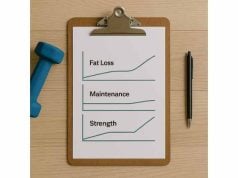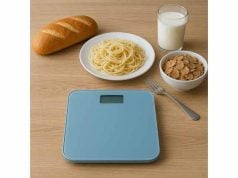
A great session tells the truth about your plan. So does a bad one. If your bar speed is slower, reps are slipping, or you dread warm-ups that used to feel automatic, your training is giving you feedback about energy, protein, carbs, hydration, and sleep. You do not need to guess. This guide shows how to read those signals, fix what matters first, and decide whether to hold, deload, or eat more. It is written for lifters cutting body fat as well as people holding maintenance who feel their performance drifting. If you are stuck in a plateau or juggling diet phases, our structured plateau and maintenance troubleshooting pairs well with the steps below.
Table of Contents
- Why is my strength going down?
- Protein, carbs and strength
- Deficit size and training load
- Sleep, stress and recovery
- When to pause or eat more
- Troubleshooting your gym performance
- Evidence and number ranges
- Frequently Asked Questions
Why is my strength going down?
Strength is sensitive to energy balance and recovery. When performance drifts, it usually points to one or more of five levers: calories, carbohydrates, protein, sleep/stress, and program design. The good news is that each lever offers a specific fix. The art is choosing the smallest change that restores quality without derailing fat loss.
What falling strength often signals
- Lower glycogen and water. A real deficit empties muscle glycogen. Sets near failure feel heavier, bar velocity slows, and pump is muted.
- Protein shortfalls. Inadequate protein reduces muscle protein synthesis and may increase soreness for the same volume.
- Hidden NEAT drop and fatigue. Daily movement falls during cuts, but fatigue rises. You move less between sets, take longer rests, and unconsciously reduce intent.
- Sleep debt and stress. Short nights increase perceived effort and reduce power output.
- Program mismatch. Volume and proximity to failure that felt fine when fed can be too much in a deficit.
How to interpret common patterns
- Strength steady, work capacity down: carbs and hydration are likely low; consider shifting carbohydrate timing around training.
- Top-end strength dips, pump is fine: total calories may be too tight; a small refeed or maintenance week can restore CNS readiness.
- Everything feels slow, motivation drops: sleep debt or life stress is high; fix recovery before you touch macros.
- No progress for three weeks despite perfect adherence: your deficit is likely too aggressive for the program; reduce volume or raise calories modestly.
First actions that solve most slumps
- Confirm protein and carbs. Protein at 1.6–2.2 g/kg of goal body weight; at least 1–1.5 g/kg of carbs on lifting days for most lifters, more if sessions are long.
- Time carbs when they matter. Place 30–50% of your day’s carbs in the window 90 minutes pre-lift through 60 minutes post-lift.
- Cap proximity to failure. In a cut, keep most working sets at RPE 7–8, leaving 1–3 reps in reserve.
- Protect frequency, trim volume. Hit each pattern 2–3×/week; remove junk sets; keep high-quality top sets.
- Stabilize sleep. Fixed wake time, 7–9 hours in bed, and a quiet wind-down routine.
New to the fundamentals behind fat loss and training? Our concise weight loss guide can help you align calorie targets, protein, and movement before you fine-tune performance.
Protein, carbs and strength
Your diet’s macronutrient split shapes how training feels rep by rep. Protein preserves lean mass, while carbohydrates fuel hard sets and keep bar speed high. Fats support hormones and satiety, but pushing them too high at the expense of carbs can make lifting grindy during a cut.
Protein: set the floor first
- Daily target: 1.6–2.2 g/kg of goal body weight.
- Per-meal target: 25–40 g across 3–5 meals.
- Practical anchors: include a lean protein at breakfast and lunch to reduce evening cravings and protect training later in the day.
Carbohydrates: performance currency
- Daily range on lifting days: 1–3 g/kg, scaled to session length and total volume.
- Timing: Put 30–50% of your carbs around training: a pre-lift meal 60–120 minutes before and a post-lift meal within 1–2 hours after.
- Food choices: rice, potatoes, oats, fruit, low-fat dairy, and simple carbs during very long sessions if needed.
Fats: enough, not excessive
- Baseline: 0.6–1.0 g/kg per day for most adults.
- Keep pre-lift fat lower to avoid sluggishness; save richer foods for later.
When macros are right but you still feel flat
- Check hydration and sodium—a small bump in fluids and electrolytes often restores pump and bar speed, especially in hot weather.
- Confirm fiber (25–35 g/day). Too little increases hunger; too much right before training can bloat and slow you down.
- Consider creatine monohydrate (3–5 g/day). It reliably supports high-intensity performance and lean mass, with or without a deficit.
If macro setup is new territory, our guide to maintenance macros walks through building plates that support both training and appetite control.
Deficit size and training load
Programming does not exist in a vacuum. The bigger the energy deficit, the less volume and proximity to failure your body can productively recover from. Get this match wrong and progress stalls—not because your plan is “bad,” but because recovery capacity shrank while training demands stayed the same.
Match the plan to the phase
- Small deficit (≈5–15% below maintenance): keep normal frequency; aim for 8–15 quality sets per muscle per week; most sets at RPE 7–8.
- Moderate deficit (≈15–25%): trim volume by 20–30%; maintain intensity on top sets; add a deload every 4–6 weeks.
- Aggressive mini-cut (≈25–30% for 2–4 weeks): shift to a maintenance microcycle: each pattern 1–2×/week, 2–3 hard sets, high intent, low junk volume.
Bar speed and RPE caps
- Use velocity or RPE ceilings to keep quality high. When bar speed drops sharply or sets creep to RPE 9–10 every session, you are likely out-kicking your recovery.
How to adjust without losing momentum
- Trim sets, not exercises. Keep your big patterns (squat, hinge, push, pull) and reduce extra sets.
- Hold frequency steady. Two or three exposures per week per pattern maintain skill and strength better than one marathon day.
- Cluster or rest-pause sparingly. Great tools when fed; fatiguing when lean. Use them only on key lifts and only briefly.
When the scale is flat and strength is sliding
- Confirm the deficit is real (weekend calories, alcohol, and oil portions are the usual suspects).
- If adherence is solid, reduce the deficit by 100–200 kcal/day for two weeks and watch bar speed, mood, and sleep. Many lifters perform better and lose fat more consistently with a slightly smaller gap.
Not sure how long to keep pushing the deficit? Review signs that it is time to pause in our primer on how long to stay in a deficit.
Sleep, stress and recovery
Poor sleep and high stress make weights feel heavier independent of calories and macros. They also raise cravings and lower daily movement, quietly shrinking your energy expenditure and your patience.
What short sleep does in the gym
- Increases perceived exertion by about 1–2 RPE for the same load.
- Reduces power output and coordination, so warm-ups feel clumsy and top sets stall early.
- Increases water retention, which can hide fat loss on the scale and tempt you to overcorrect.
Fast wins for better sessions
- Fixed wake time, 7–9 hours in bed, and a 30–60 minute wind-down routine.
- Morning light and a 10–20 minute walk to anchor your body clock.
- Caffeine cutoff 8–10 hours before bed; avoid new max tests after poor nights.
- Carbs near training (+ fluids and sodium) when sleep is short; keep RPE caps lower.
If sleep debt and stress are the main culprits, start by repairing recovery. Our integrated plan for sleep and cortisol shows how to stabilize nights and regain training quality without abandoning your deficit.
When to pause or eat more
Sometimes the best way to preserve strength and keep fat loss moving is to step out of the deficit briefly. A diet break (1–2+ weeks at calculated maintenance) or refeeds (1–2 days at maintenance, carb-focused) can restore bar speed, mood, and adherence.
Use a short maintenance phase when:
- Strength has drifted down for 3+ weeks despite solid sleep, protein, and program adjustments.
- Hunger is high all day and you are white-knuckling adherence.
- Training quality is dropping even after trimming volume and managing RPE.
How to run it
- Calculate current maintenance from your recent intake and weight trend.
- Keep protein high and training frequency the same; do not “go wild.”
- Allocate the extra calories mostly to carbs around training; keep fats moderate.
Refeeds: smaller tool, specific use
- Place refeed days on hardest sessions to support performance and morale.
- Plan the menu in advance; do not treat refeed as a free-for-all.
If you are unsure whether a pause is the right move, the decision-making framework in when to raise calories can help you weigh trade-offs clearly.
Troubleshooting your gym performance
Work through this checklist before making big changes. Small, targeted fixes solve most performance dips in a week or two.
One-week triage
- Day 1–2: Verify protein and carbs. Anchor 25–40 g protein at the first two meals; add 30–60 g of carbs 60–90 minutes pre-lift plus a post-lift carb-protein meal.
- Day 3–4: Audit hydration and sodium; aim for clear to pale-yellow urine and include a pinch of salt at pre-lift meals, more in heat.
- Day 5–7: Stabilize bedtime and wake time; cap training sets at RPE 7–8; remove intensifiers (drop sets, grinders).
If bar speed and mood improve, keep the plan and reassess in 7–10 days.
If not, choose one of these:
- Trim volume 20–30%. Keep frequency and top sets; remove accessory fluff.
- Add 100–200 kcal/day (mostly carbs) for two weeks; judge by performance and average weekly weight.
- Deload for 4–7 days: same exercises, ~60–70% normal volume, ~60–80% normal load, strict technique.
Common blind spots
- Weekend calories erasing your weekday deficit and blurring feedback.
- Alcohol fragmenting sleep and sapping Monday training.
- Program monotony—no variation in rep ranges or movement patterns, leading to joint irritation and stale motivation.
For a broader diagnostic on stalls (scale and performance), use our structured plateau check in 2–4 weeks to separate noise from true plateaus.
Evidence and number ranges
Use these planning ranges to align food, training, and recovery without chasing perfect numbers. Individual responses vary; trends over 2–4 weeks matter more than any single day.
- Protein to preserve lean mass: 1.6–2.2 g/kg of goal body weight daily, split across 3–5 meals.
- Carbs to support lifting: 1–3 g/kg on training days, with 30–50% near the session window.
- Fats for hormones and satiety: 0.6–1.0 g/kg daily.
- Deficit sizing: small (5–15%), moderate (15–25%), aggressive (25–30% for 2–4 weeks).
- Volume guidance in a cut: 8–15 sets/muscle/week in small deficits; reduce 20–30% in moderate deficits; maintain a “practice dose” in aggressive phases.
- Sleep: 7–9 hours in bed; short nights raise RPE and reduce power.
- Performance expectations: modest strength dips during cuts are common; skill, technique, and bar speed usually rebound within 1–3 weeks at maintenance.
- Progress pace: sustainable fat loss averages 0.5–1.0% body weight per week when performance, protein, and sleep are aligned.
These numbers keep your plan grounded. When sessions feel off, check them first—and change the smallest variable that restores quality.
Frequently Asked Questions
Why is my strength dropping while dieting?
Energy deficit lowers glycogen and increases fatigue, so sets feel heavier and bar speed slows. If protein or carbs are low—or sleep is short—performance dips more. Keep protein at 1.6–2.2 g/kg, time carbs around training, cap RPE at 7–8, and stabilize sleep.
How many carbs do I need to lift well?
Most lifters do well with 1–3 g/kg of carbs on training days, scaled to session length and volume. Place 30–50% of that near training: a pre-lift meal 60–120 minutes before and a post-lift meal within 1–2 hours after to support bar speed and recovery.
Should I train to failure during a cut?
Generally no. Save true failure for occasional top sets on key lifts. In a deficit, most working sets should land at RPE 7–8 (1–3 reps in reserve). This preserves stimulus with less fatigue and helps you keep frequency and technique crisp across the week.
How fast will strength return at maintenance?
Bar speed and reps often rebound within one to three weeks at maintenance if sleep and carbs improve. Keep frequency, restore volume gradually, and allocate more carbs around training. Many lifters hit pre-cut performance within a training block or two.
Do creatine or caffeine prevent strength loss?
Creatine (3–5 g/day) supports high-intensity performance and lean mass. Caffeine can improve power and perceived effort when used thoughtfully. They help, but they cannot replace adequate carbs, protein, sleep, and a program matched to your current recovery capacity.
How do I tell fatigue from under-eating?
If a small carb bump around training and one deload week restore bar speed, fatigue was the main driver. If performance stays low, hunger is high, sleep is fine, and recovery feels limited, your deficit may be too large. Add 100–200 kcal/day and reassess for two weeks.
References
- A systematic review, meta-analysis and meta-regression of the effect of protein supplementation on resistance training-induced gains in muscle mass and strength in healthy adults 2018 (Systematic Review & Meta-analysis)
- The Effect of Carbohydrate Intake on Strength and Resistance Training Performance: A Systematic Review 2022 (Systematic Review)
- Resistance training prescription for muscle strength and hypertrophy in healthy adults: a systematic review and Bayesian network meta-analysis 2023 (Systematic Review & Network Meta-analysis)
- Effects of Acute Sleep Deprivation on Sporting Performance in Athletes: A Comprehensive Systematic Review and Meta-Analysis 2024 (Systematic Review & Meta-analysis)
- International Society of Sports Nutrition position stand: safety and efficacy of creatine supplementation in exercise, sport, and medicine 2017 (Guideline/Position Statement)
Medical Disclaimer
This guide provides general education about training performance, nutrition, and recovery. It is not a substitute for medical advice, diagnosis, or treatment. Consult your licensed healthcare professional before changing your diet, supplements, or training plan—especially if you have injuries, chronic conditions, or take prescription medications.
Share and Follow
If this article helped you decode your training, consider sharing it with a friend who is troubleshooting a cut. You can also follow us on Facebook, X, or any platform you use for practical updates and step-by-step guides.










